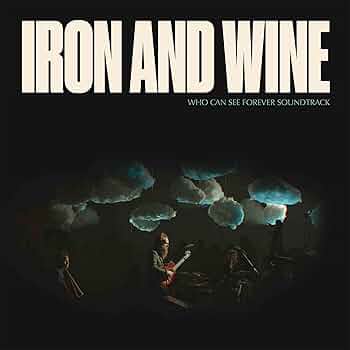
Sam Beam has been recording as Iron and Wine for over 20 years, so the thought of looking back at his career with a live concert film, Who Can See Forever makes sense. Evolving in much the same way his career has, the film evolved and what has now been released encompasses far more than just an on-stage performance. Billed as a “visual portrait,” it captures a man who exists as more than just a singer/songwriter. Having earned four Grammy nominations in four years, the film is a behind the scenes look at a man who is also an artist, husband and father. Professionally he has recorded with Jesca Hoop, Ben Bridwell of Band of Horses and Calexico. Despite having covered so much territory, he always seems to be looking for new ways to reinvent his music.
The album, recorded by his sound engineer, Jelle Kuiper and mixed by Matt Ross-Sprang, offers an intimate portrait of an artist, who despite limited sales, has managed to be a respected performer. Falling somewhere between a soundtrack and a best-of collection, these nineteen songs offer a glimpse of Beam with a band comprised of drummer Beth Goodfellow, keyboardist Elizabeth Hardy-Jones, cellist Teddy Rankin-Parker and bassist Sebastian Steinberg. What emerges is a portrait of an artist who is satisfied with rote reworkings of his back catalog.
Placing songs like songs like ‘Sodom, South Georgia’ and ‘The Trapeze Swinger’ in a new contexts offers a chance for reappraisal. ‘House By the Sea’ comes alive thanks to the drumming of Goodfellow, while ‘About a Bruise’ charms with the keyboards of Hardy-Jones playing a new role and vocals that explore areas that one wouldn’t expect.
Beam’s approach to this material offers plenty of room for the band to examine familiar songs in ways that aren’t always straight forward. What they reveal is the way Beam is willing to rearrange the music based on the differing instrumentation. ‘Last Night’ starts with a prolonged cacophonous burst before almost settling in. The familiar, yet unfamiliar moments seem almost Zappa-esque, not something one would expect from Iron and Wine. It takes more than a little bravery to colour outside the lines. Trusting an audience to be willing to take as many chances as the band does illustrates Beam’s own inclination to explore new shades and concepts.
For every chance he takes, he also seems to have songs that stay fairly close to the tried-and-true approach of the originals. ‘Passing Afternoon’ feels close while still straying a distance from the old arrangement. Rearranged for guitar and bass, ‘Naked As We Came’ still retains the beauty that made the song such a lovely number so many years ago.
Following his muse wherever it leads him, Sam Beam has crafted Who Can See Forever with the kind of care that makes these 19 songs something quite special. He has changed the hues, but the heart and soul of these songs still shine through in ways that reveal what a truly special artist he remains.









